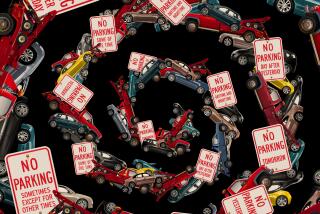Toll lanes: Which way?
- Share via
Re “A toll on roads, and our souls,” Opinion, June 10
Tim Rutten views toll lanes as unfair, comparing a hypothetical single mother and a wealthy partner who both leave a downtown Los Angeles law office at noon -- the mother to get her sick child from day-care. Both would pay tolls to avoid traffic -- trivial for the partner but a financial burden for her.
Imagine the same scenario with no toll lanes. Our single mother hopes she’ll lose only two hours of work time, but the freeways are jammed. She arrives at day-care late; the rest of her workday is lost.
With a toll lane, this woman would have had an alternative to sitting in traffic. And the toll paid by the fat-and-happy partner? Those revenues can help fund transit projects.
Rutten’s experiment is most useful when compared with the reasonable alternative: What would all of us do in the same circumstance without the option to use toll lanes?
Marlon G. Boarnet
Irvine
The writer is a professor of planning, policy and design at UC Irvine.
Congestion pricing is classic neocon thinking: Do something that makes rich people’s lives easier, while avoiding the need to invest in trains and subways.
Jon Hartmann
Los Angeles
::
When I get on the freeway at rush hour, I slow other people up. I ignore this cost because I do not pay it. When I decide to make a trip, I compare only the costs I must pay to the benefits the trip provides.
The equity concerns raised by Rutten are misplaced. Not only do tolls improve efficiency, they also improve fairness because they force the traveler to account for the effects of his or her choices on everyone else.
James E. Moore
Los Angeles
The writer is a professor of industrial and systems engineering at USC.
::
Thanks, Tim Rutten, for telling the bitter truth about toll roads and our continuing disregard for fairness and social justice. How hard would it be to stop protecting health insurance companies, drug manufacturers, financial speculators and “developers” of white-elephant toll roads who prosper at the expense of our most vulnerable fellow Americans?
Felix Schwarz
Irvine
::
In fact, the recent Rand Corp. congestion pricing study that we sponsored indicates that congestion pricing can improve traffic flows and reduce pollution without burdening the poor if the project is planned right.
Among all road pricing models, high-occupancy toll lanes that are next to free lanes are the easiest to design to ensure mobility and access, regardless of income level.
Whether those lanes also are designed and operated to reduce dangerous air and global warming pollution is harder to determine.
Among other things, it will require a strong commitment by the MTA, which soon will hold hearings on local lane conversion projects, to provide reliable and frequent transit service in the corridor.
Kathryn Phillips
Sacramento
The writer is director of the California Transportation and Air Initiative at the Environmental Defense Fund.






